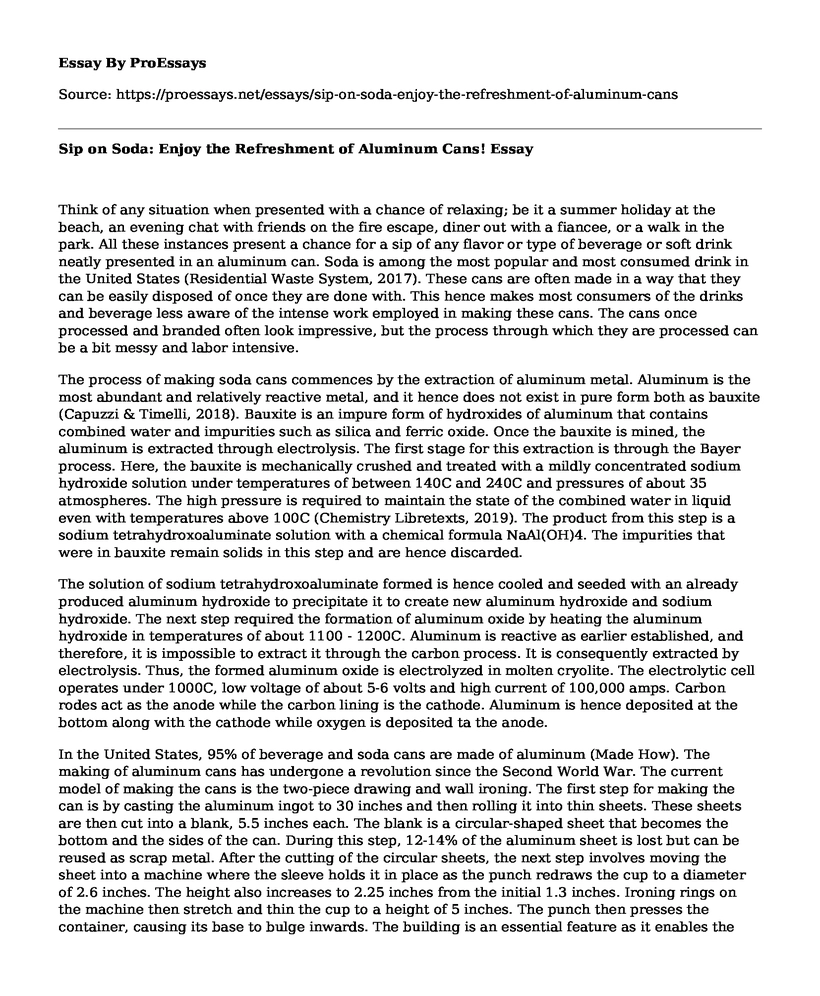Think of any situation when presented with a chance of relaxing; be it a summer holiday at the beach, an evening chat with friends on the fire escape, diner out with a fiancee, or a walk in the park. All these instances present a chance for a sip of any flavor or type of beverage or soft drink neatly presented in an aluminum can. Soda is among the most popular and most consumed drink in the United States (Residential Waste System, 2017). These cans are often made in a way that they can be easily disposed of once they are done with. This hence makes most consumers of the drinks and beverage less aware of the intense work employed in making these cans. The cans once processed and branded often look impressive, but the process through which they are processed can be a bit messy and labor intensive.
The process of making soda cans commences by the extraction of aluminum metal. Aluminum is the most abundant and relatively reactive metal, and it hence does not exist in pure form both as bauxite (Capuzzi & Timelli, 2018). Bauxite is an impure form of hydroxides of aluminum that contains combined water and impurities such as silica and ferric oxide. Once the bauxite is mined, the aluminum is extracted through electrolysis. The first stage for this extraction is through the Bayer process. Here, the bauxite is mechanically crushed and treated with a mildly concentrated sodium hydroxide solution under temperatures of between 140C and 240C and pressures of about 35 atmospheres. The high pressure is required to maintain the state of the combined water in liquid even with temperatures above 100C (Chemistry Libretexts, 2019). The product from this step is a sodium tetrahydroxoaluminate solution with a chemical formula NaAl(OH)4. The impurities that were in bauxite remain solids in this step and are hence discarded.
The solution of sodium tetrahydroxoaluminate formed is hence cooled and seeded with an already produced aluminum hydroxide to precipitate it to create new aluminum hydroxide and sodium hydroxide. The next step required the formation of aluminum oxide by heating the aluminum hydroxide in temperatures of about 1100 - 1200C. Aluminum is reactive as earlier established, and therefore, it is impossible to extract it through the carbon process. It is consequently extracted by electrolysis. Thus, the formed aluminum oxide is electrolyzed in molten cryolite. The electrolytic cell operates under 1000C, low voltage of about 5-6 volts and high current of 100,000 amps. Carbon rodes act as the anode while the carbon lining is the cathode. Aluminum is hence deposited at the bottom along with the cathode while oxygen is deposited ta the anode.
In the United States, 95% of beverage and soda cans are made of aluminum (Made How). The making of aluminum cans has undergone a revolution since the Second World War. The current model of making the cans is the two-piece drawing and wall ironing. The first step for making the can is by casting the aluminum ingot to 30 inches and then rolling it into thin sheets. These sheets are then cut into a blank, 5.5 inches each. The blank is a circular-shaped sheet that becomes the bottom and the sides of the can. During this step, 12-14% of the aluminum sheet is lost but can be reused as scrap metal. After the cutting of the circular sheets, the next step involves moving the sheet into a machine where the sleeve holds it in place as the punch redraws the cup to a diameter of 2.6 inches. The height also increases to 2.25 inches from the initial 1.3 inches. Ironing rings on the machine then stretch and thin the cup to a height of 5 inches. The punch then presses the container, causing its base to bulge inwards. The building is an essential feature as it enables the can to withstand the pressure exerted by the liquid it contains. All these processes are termed as drawing and ironing.
The rugged top or ears of the cup is then trimmed. It is then tightly squeezed to form a neck consisting of an outer flange which is only folded over once all the processes are done. The drawing and ironing steps often leave the surface of the can smooth and hence branding and decorating them do not require any further polishing. The lid of the can is made for a slightly different alloy from that of the cup. The cap is hence made from an alloy of aluminum, with relatively more magnesium and less manganese. The diameter of the lid is 2.1 inches and it is thicker than the can wall or base. Its center is also stretch upward and drawn by a rivet and the pull tab inserted under the rivet. The lid is hence scored to enable the smooth opening of the can. The can is ready for filling and sealing.
References
Aluminum beverage can. Made how. Retrieved from http://www.madehow.com/Volume-2/Aluminum-Beverage-Can.html
Aluminum metallurgy (2019). Chemistry Libretexts.
Capuzzi S. & Timelli G. (2018). Preparation and Melting of Scrap in Aluminum Recycling: A Review. Open Access Metallurgy Journal. vol. 8. pp. 1-24. Doi: 10.3390/met8040249
Residential waste systems. (2017). The Life Cycle of a Soda Can. https://residentialwastesystems.com/blog/life-cycle-soda-can/
Cite this page
Sip on Soda: Enjoy the Refreshment of Aluminum Cans!. (2023, Jan 16). Retrieved from https://proessays.net/essays/sip-on-soda-enjoy-the-refreshment-of-aluminum-cans
If you are the original author of this essay and no longer wish to have it published on the ProEssays website, please click below to request its removal:
- Ecology Quiz Results Summary
- My Dietary Assessment
- Essay Sample on Effects of Fog on Distance and Speed Perception
- Los Angeles Water Sustainability Problem - Research Paper
- Essay on U.S. CAFE Standards: Reducing Pollution & Increasing Fuel Economy
- Cultural Anthropology: Exploring Societies and Cultures - Essay Sample
- Paper Example on Urban Pollution and Lack of Sustainability: Impact on Transportation System







